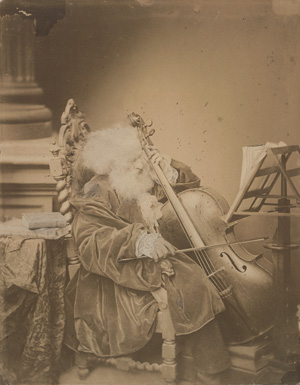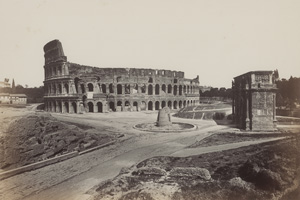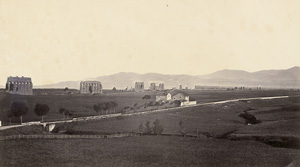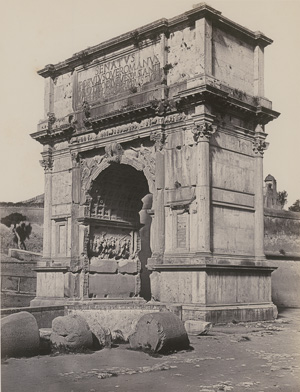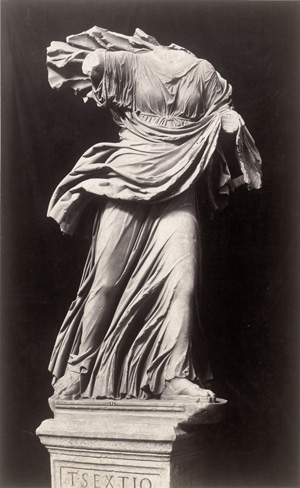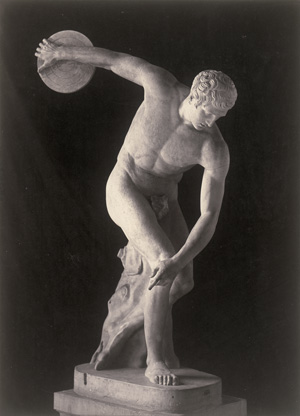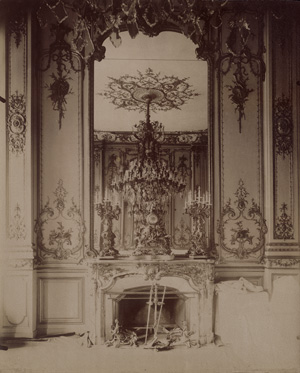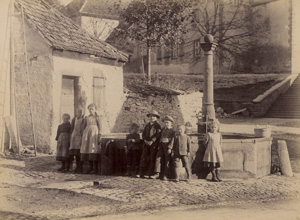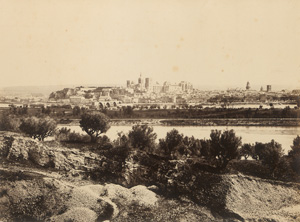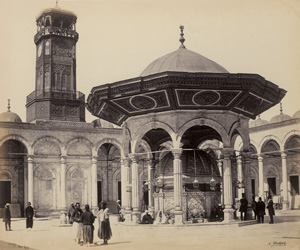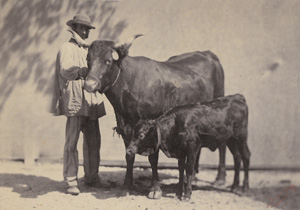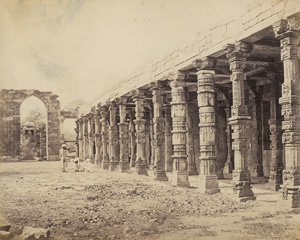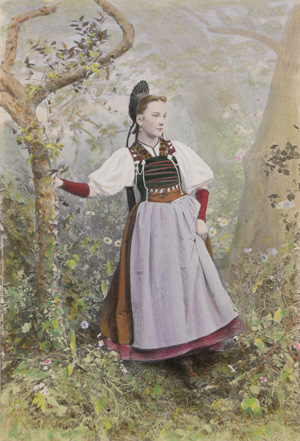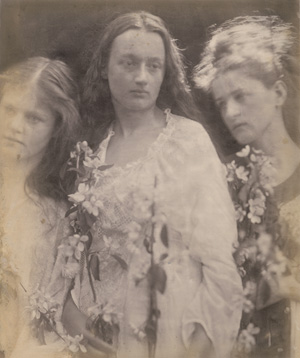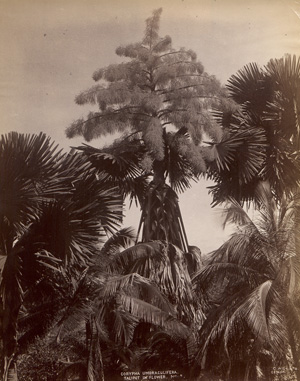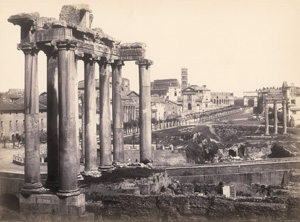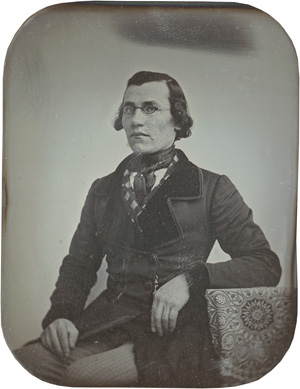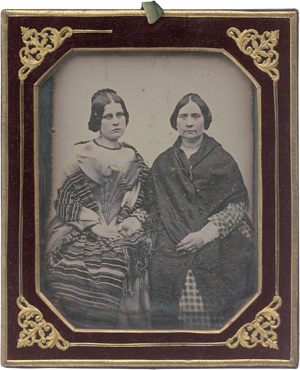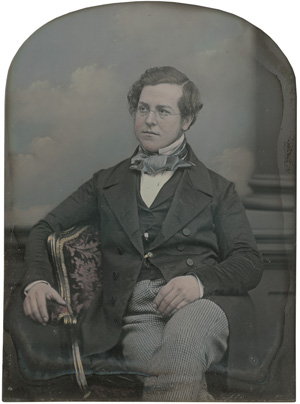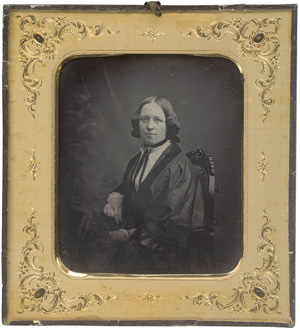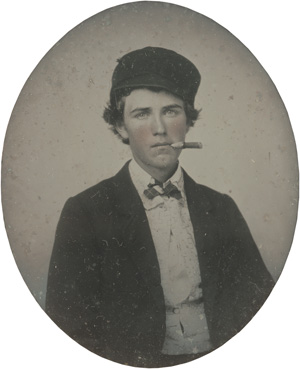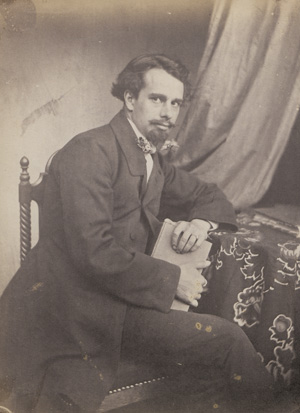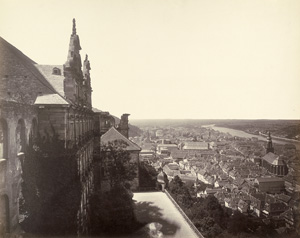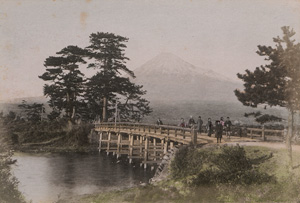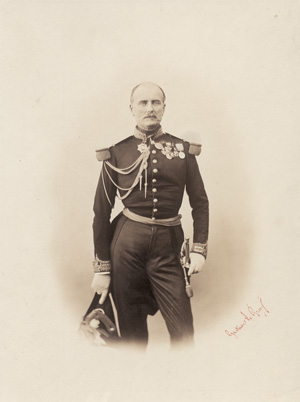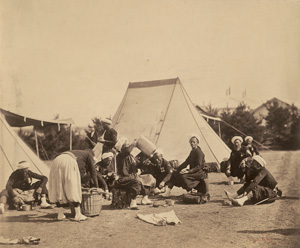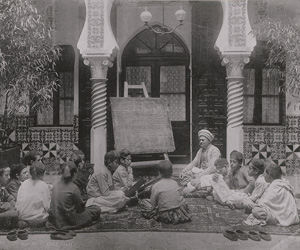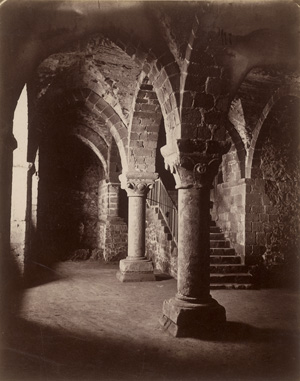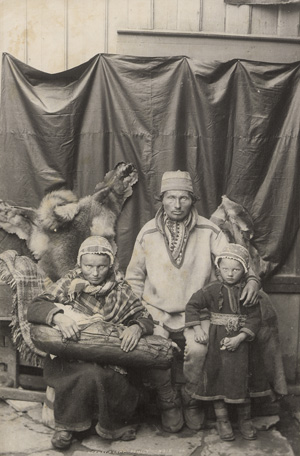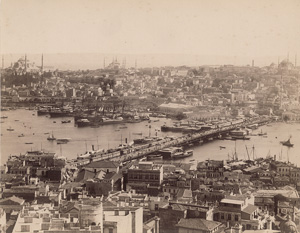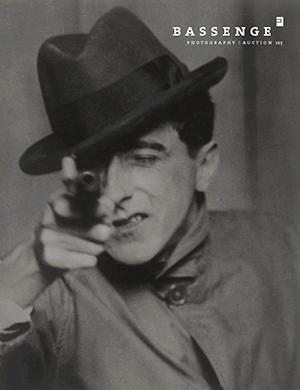
Adam-Salomon, Antoine Samuel
Self-Portrait with Cello
Los 4001
Nachverkaufspreis
1.000€ (US$ 1,111)
Self-Portrait with Cello. Circa 1860. Albumen print. 26,4 x 20,8 cm. Mounted to board, annotated in pencil on the verso.
Antoine Samuel Adam-Salomon was a pioneering French sculptor and photographer, who elevated portrait photography to an art form through his expert use of lighting, shadow, and composition. His portraits were renowned for their depth and sculptural quality, rivaling painting in richness and realism. In recognition of his achievements, he was awarded the Legion of Honor in 1870. – Some scuff marks, surface irregularities and signs of retouching, otherwise in good condition.
Anderson, James and Tommaso Cuccioni
View of the Colosseum; Arch of Constantine; Temple of Hercules Victor; Arch of Drusus
Los 4008
Nachverkaufspreis
1.000€ (US$ 1,111)
View of the Colosseum; Arch of Constantine; Temple of Hercules Victor; Arch of Drusus. 1857-early 1860s. 4 large-format albumen prints. 33,5 x 45,5 cm 39,5 x 31,7 cm, 29 x 38,7 cm and 32,5 x 45 cm. Each mounted to board (traces of use, some spots, slightly dusty), titled in Italian in ink below the image on the mount, Drusus print with "Fotografia Cuccioni, via Condotti 19, ROMA" blind stamp under the image on the mount.
Born Isaac Atkinson in Blencarn, Cumberland, England, James Anderson initially pursued studying painting in Paris. In 1838, he relocated to Rome and embarked on a career in sculpture under the name James Anderson, which he kept professionally. Eleven years later, he ventured into photography, establishing a studio in Rome in 1853. He specialized in reproductions of works of art, frequently publishing catalogs of his work and also photographed views of Italy and antiquities. Throughout the 1860s, Anderson exhibited extensively. Following his passing, his son Domenico assumed control of the studio, which remained in the family's hands until the 1940s. – Colosseum print with some fading in edges in lower area, all with a few surface scuff marks, some retouched spots, some foxing in sky area, otherwise in very good condition with strong violet-brown tones.
Lit.: Dorothea Ritter. Rom 1846-1870. James Anderson und die Maler-Fotografen, Sammlung Siegert. Munich 2005, ill. p. 47 (Arch of Drusus, attributed to James Anderson).
Anderson, James and Unknown
Panoramic view of Roman Campagna to the Alban Hills, etc.
Los 4009
Nachverkaufspreis
800€ (US$ 889)
Panoramic view of Roman Campagna to the Alban Hills; Views of Tivoli; San Benedetto convent, Subiaco; Panoramic view of Rome from Monte Mario; View of Rome over the Tiber River from Monte Aventino. Late 1850s. 3 large-format albumen panoramas and 3 albumen prints. 23 x 41 cm and 17 x 24 cm. Each mounted to thick card (soiled and time-stained in edges, some small tears), each annotated in ink below the image on the mount.
Campagna print with some foxing in sky area, a few light scuff marks, Monte Mario print with light foxing in sky area and some fading in lower edge. Rome over Tiber River print with larger retouched area in mid lower portion, some light surface scuffing, otherwise in good condition, smaller prints in very good condition.
Lit.: Dorothea Ritter. Rom 1846-1870. James Anderson und die Maler-Fotografen, Sammlung Siegert, Munich 2005, compare ill. p. 87 (similar image of Campagna).
Dietmar Siegert. Rom vor hundert Jahren. Photographien 1846-1890. Munich 1985, ill. p. 52 (foldout).
The Arch of Titus, Rome. Circa 1860. Large-format albumen print. 39,5 x 30,2 cm. Mounted to board (slightly dusty), "Jos. Spithöver Roma" blind stamp in lower right corner of the mount, titled in Italian in ink below the image on the mount.
A few surface scuff marks, otherwise in very good condition with strong violet-brown tones.
Anderson, James
Statues of Niobide, Vatican; Sophocles, Laterna Museum and Mars, Villa Ludovisi
Los 4012
Nachverkaufspreis
1.000€ (US$ 1,111)
Statues of "Niobide", Vatican; "Sophocles", Laterna Museum and "Mars", Villa Ludovisi. 1855-60. 3 large-format gold-toned albumen prints. Each circa 37 x 23 cm. Each mounted to board (traces of use, foxing, time-stained in edges), titled in Italian in ink below the image on the mount, each with "Jos. Spithoever, Roma" blind stamp in lower right corner of the mount.
James Anderson's rendition of sculpture is exceptional, likely due to his own experience as a sculptor. His images of sculpture far surpass other art reproductions of the time and stand out as individual works. The prints are gold-toned, giving them a rich, violet brown color that exceeds the quality of images found in travel albums of the time. – A few surface scuff marks, some retouched spots, otherwise in near excellent condition with strong violet-brown tones.
Anderson, James
Statues of "Diskobolus"; "Laocoon"; "Nilo", all Vatican
Los 4013
Nachverkaufspreis
1.000€ (US$ 1,111)
Statues of "Diskobolus"; "Laocoon"; "River Nile", all Vatican. 1855-60. 3 large-format gold-toned albumen prints. Each circa 37,5 x 27,5 cm. Each mounted to board (traces of use, some foxing, time-stained in edges), titled in Italian in ink below the image on the mount, each with "Jos. Spithoever, Roma" blind stamp in lower right corner of the mount.
A few light surface scuff marks, some retouched spots, otherwise in near excellent condition with strong violet-brown tones.
Atget, Eugène
Hôtel De Roquelaure, 246 Boulevard St. Germain, Paris
Los 4017
Nachverkaufspreis
800€ (US$ 889)
Hôtel De Roquelaure, 246 Boulevard St. Germain, Paris. Circa 1906-1907. Albumen print. 21,7 x 17,7 cm. Titled and numbered "5314" by the photographer in pencil on the verso.
Slight crease in lower margin, upper margin slightly uneven, otherwise a strong tonal print in very good condition.
Photographer unknown. Views of Badenweiler. Circa 1900. 29 albumen prints. Each circa 17 x 23 and reverse. Mounted to boards (time-stained in edges, some dusty, slightly warped).
Some light surface scuff marks, some with light fading in edges, otherwise prints in good to very good condition.
Avignon. Circa 1861. Albumen print. 31,3 x 42,5 cm (44 x 55 cm). Mounted to original card (some foxing, creases and tears), stamped "Avignon" and "E. Baldus" in black ink below image on mount.
Prints of this image are in the collections of the Metropolitan Museum of Art and the Museum of Fine Arts, Houston. – Some foxing, scuff marks, and light surface irregularities, along with slight signs of oxidation in the shadow areas, otherwise, in very good condition.
Cairo and Thebes. 1862. 2 albumen prints mounted to board. 23,8 x 28,5 cm (29,4 x 33,9 cm) and 27 x 22 cm (31,2 x 26,9 cm). Signed, numbered, titled and dated in the negative in lower margin; annotations by another hand in pencil on the mount below the image.
In 1862, Francis Bedford was commissioned to accompany the Prince of Wales on a royal tour of the Eastern Mediterranean. He produced some of the earliest photographs of Egypt taken under official patronage. His images captured major archaeological sites such as the Pyramids of Giza, the Sphinx, Karnak, and the temples of Thebes and Philae, as well as scenes of daily life along the Nile. Technically refined and compositionally balanced, these photographs were later exhibited and published in Britain, and shaped Victorian perceptions of Egypt. – Some light fading, smudge marks and minimal foxing, otherwise in very good condition.
Prize animals. Circa 1857. Albumen print. 13,3 x 19,2 cm (25,6 x 33,2 cm). Photographer’s studio stamp in red ink in the lower left corner of print, mounted on board (some foxing and smudge marks), “Photographe de S.M. L’Empereur” embossed on the mount in lower margin.
Some scuff marks, otherwise a strong print in very good condition.
Views of India and Sri Lanka. 1860s. 21 albumen prints mounted to album boards. Each between 15,5 x 23 cm and 24,3 x 28,5 cm or reverse (34,5 x 42,8 cm). Most with photographer's name and/or negative number in the margins.
Samuel Bourne was a pioneering British photographer celebrated for his extensive documentation of 19th-century India and Sri Lanka. Between 1863-1870, he produced over 2,000 images capturing the subcontinent’s diverse landscapes, architectural marvels, and colonial infrastructure. This selection of photographs features scenic vistas and colonial-era landmarks across India and Sri Lanka, including Shimla and its Christ Church, the Qutb Minar in Delhi, the Marble Rocks at Jabalpur, the Colombo-Kandy railway in Sri Lanka, the Satkhanda Tower in Lucknow, as well as a view of Eden Gardens in Calcutta, alongside lush Himalayan forests, rivers, and hill stations. – Some fading, scuff and smudge marks, otherwise all in good to very good condition.
Two prints from the book Costumes de Suisse: "Canton de Schaffhouse"; "Canton d' Appenzell". 1870s. 2 delicately hand-colored albumen prints. Each circa 15 x 10 cm. Each mounted to original card (slight foxing), photographer's name, title and book title printed below/above the image on the mount. Matted.
Prints in very good condition.
Lit.: Maureen C. O'Brien/Mary Bergstein (eds.). Adolphe Braun. Image and Enterprise. London 2000, ill. p. 150 (uncolored variant of "Canton d' Appenzell").
Cameron, Julia Margaret
Three King's Daughters Fair
Los 4028
Nachverkaufspreis
4.000€ (US$ 4,444)
Three King's Daughters Fair (Mary Peacock, Emily Peacock, Annie Chinery Cameron). 1873. Albumen print. 33,2 x 27,8 cm (44,2 x 37,7 cm). Mounted to modern board.
Julia Margaret Cameron’s Three Kings’ Daughters Fair embodies her pioneering vision of elevating photography into the realm of fine art. Drawing inspiration from the Pre-Raphaelite Brotherhood, Victorian poetry, and her close relationships with leading literary and artistic figures of her time, Cameron cultivated an aesthetic that was both intimate and transcendent. The title of this work originates from a ballad translated by Dante Gabriel Rossetti, whose romantic medievalism profoundly shaped Cameron’s approach. The photograph’s dreamlike quality - soft focus, luminous faces, and floral symbolism - evokes an allegorical reverie oscillating between portraiture and poetic myth. The sitters - Mary and Emily Peacock, along with Cameron’s daughter-in-law, Annie Chinery Cameron - were part of her creative circle, often posing as literary and mythological figures in her staged compositions. Their presence in this image extends beyond mere likeness, rather symbolizing vessels of narrative and sentiment, in keeping with Cameron’s belief that photography should aspire to the expressive depth of painting and poetry. At a time when photographic sharpness was equated with technical prowess, Cameron defied convention by embracing soft focus as a means of artistic interpretation. Her ethereal, often melancholic compositions prefigured the Pictorialism movement, challenging rigid definitions of the medium, and establishing her legacy as one of the 19th century’s most innovative photographers. – Some light surface irregularities and fading along edges of print, otherwise a strong print in near excellent condition.
Lit.: Mike Weaver. Julia Margaret Cameron 1815-1879. Farnham 1984, ill. p. 72.
Amanda Hopkinson. Julia Margaret Cameron. London 1986, ill. p. 135.
Julian Cox and Colin Ford. Julia Margaret Cameron: The Complete Photographs. Los Angeles 2003, ill. p. 237.
Photographer: Colombo Apothecaries Company (active 1883-late 1920s). Botanical studies. 6 albumen prints. Each ca. 28 x 21 cm. Most signed and captioned in the negative in lower margin as well as some with "Apothecaries & Co. - Photographers - Colombo, Ceylon" blind stamp in lower right corner; annotations in pencil as well as "Dr. Arthur Berger" collection stamp on the verso.
This collection comprises botanical photographs produced by C. A. & Co., also known as the Colombo Apothecaries Company, a mercantile firm established in Colombo, Ceylon in 1883, by W.M. Smith and James Smith Finlay. The company expanded into photography by the early 1890s. They acquired the negatives of Charles T. Scowen & Co. and relocated their studio to Kandy with its favorable climate for photographic work. The images document tropical plant species, including Parmentiera cereifera (Candle Tree) and Corypha umbraculifera (Talipot Palm), each labeled with Latin names and specimen numbers. – Some light surface irregularities and handling marks, with occasional small tears and creases along the margins of a few prints, otherwise all in good to very good condition.
Provenance: Estate of Dr. Arthur Berger
Cuccioni, Tommaso and James Anderson
Forum Romanum and the Temple of Saturn; Temple of Vespasian, Rome
Los 4033
Nachverkaufspreis
1.000€ (US$ 1,111)
Forum Romanum and the Temple of Saturn; Temple of Vespasian, Rome. 1855 and circa 1860. 2 large-format albumen prints. 34 x 46 cm and 37 x 28 cm. Each mounted to original board (traces of use in edges, some spots, slightly dusty), Vespasian print with "Jos. Spithöver Roma" blind stamp in lower right, each annotated in Italian in ink below the image on the mount.
Tommaso Cuccioni was active in Rome from ca. 1830 as a lithographer and print publisher, with a studio on the centrally located Via dei Condotti, a popular destination for affluent English tourists. Embracing photography in 1852, he began producing large-format views of Roman landmarks, offering a new and highly effective form of visual souvenir. Few of these early prints survive and such large-formats are rare. – Forum Romanum with Saturn Temple print with one light foxing spot in sky area, minimal mirroring in lower dark area, more visible at an angle, both prints with a few light surface scuff marks, otherwise in very good condition with strong tones.
Lit.: Dorothea Ritter. Rom 1846-1870. James Anderson und die Maler-Fotografen, Sammlung Siegert. Munich 2005, ill. pp. 140-141.
Photographer: Jean-Baptiste Sabatier-Blot (1801-1881). Portrait of a scholar. 1840s. Quarter-plate daguerreotype in fabric-lined frame. 17 x 13 cm. Signed "Sabatier, Palais Royal 137" in ink on lower margin.
Jean-Baptiste Sabatier-Blot was a French miniaturist who transitioned to photography in 1842, opening a prominent daguerreotype studio in Paris’s Palais-Royal. One of his most significant contributions is his 1844 portrait of Louis-Jacques-Mandé Daguerre, among the few known photographs of the inventor. An active member of the photographic community, he joined the Société héliographique in 1851 and was a founding member of the Société française de photographie (1854). His works are preserved in institutions such as the Musée d’Orsay and the Bibliothèque nationale de France. – Some signs of oxidation along edges of plate, otherwise in very good condition.
Photographer: Philipp Graff (1813-1851). Portrait of two women. Circa 1845. Sixth-plate daguerreotype, with ornamental gilt and red velvet frame, mounted under glass, photographer's label, "P. Graff. Mechaniker, Optiker u. Daguerreotypist, Jerusalemerstr. No. 18" on the verso, in matching silk and velvet lined, gilt embossed leather case (some scratch/scuff marks, faded).
Julius Philipp Graff was a German entrepreneur, mechanic, optician and daguerreotypist. He made a name for himself as one of the most important Berlin portraitists and ran his photographic studio at Jerusalemer Straße 18 in Berlin. As early as 1843, he advertised his business with various labels. – Some oxidation around edges, a few small spots on plate, otherwise in good condition.
Photographer: William Edward Kilburn (1818-1891). Portrait of a gentleman. 1850s. Hand-colored quarter-plate daguerreotype in leather casing (slightly rubbed). 9,5 x 12 cm. With the photographer's "234 Regent Street" studio stamp gilt-embossed onto cover.
William Edward Kilburn was active as a daguerreotypist in London since 1846, running one of the city’s most successful studios alongside that of Richard Beard. He was the first photographer to be granted the title of court photographer to the British royal family. Kilburn’s daguerreotypes feature delicately stippled cloud backgrounds, created with a fine pigment dust - a technique he adopted from Beard. It is believed that the well-known miniature painter, L. Mansion, was responsible for these atmospheric effects. Kilburn gained international recognition at the 1851 Great Exhibition, where he was awarded a medal for his hand-colored portraits. – Some signs of oxidation along edges of plate, otherwise in very good condition.
Daguerreotypes
Portrait of a woman (Minna Schweitzer)
Los 4037
Nachverkaufspreis
600€ (US$ 667)
Photographer: Carl Gustav Oehme (1817-1881). Portrait of a woman (Minna Schweitzer). Mid-1850s. Sixth-plate daguerreotype, with ornamental gilt surround (some small spots), mounted under glass with stand prop, photographer's label, address "Jäger Str. No. 19" on the verso, in green silk lined leather case (some scratch/scuff marks, edges partially rubbed).
Carl Gustav Oehme was an early German photographer and apparatus builder. He studied the Daguerreotype process in Paris after meeting Louis Daguerre in 1840 and continued to produce daguerreotypes until 1862. The same year Oehme was awarded a medal at the World Exhibition in London. – Some oxidation around edges, a few light scuff marks on plate, otherwise a strong image in very good condition.
Photographer unknown. Young man with cigar. 1850s. Hand-colored sixth-plate daguerreotype in leather casing (edges rubbed). 9,5 x 8 cm.
Some minor oxidation spots along edges of plate, otherwise in excellent condition.
Hanfstaengl, Franz and Others
Selected early portraits of German artists
Los 4049
Nachverkaufspreis
400€ (US$ 444)
(Attributed to). Selected early portraits of German artists (Munich?). 1850s. 3 salted paper prints from calotype negatives. Each circa 18 x 15 cm.
Fading in edges, otherwise in good condition.
Photographer unknown. View of Heidelberg from the castle terrace. Mid-1860s. Mammoth albumen print from a collodion glass plate negative. 40,2 x 50,5 cm. Mounted to board (slight traces of use).
This image is not published in Milan Chlumsky (ed.). Das Heidelberger Schloß in der Fotografie vor 1900. Heidelberg 1990. – A few light surface scratches and surface rubbing, a few retouched spots in dark areas, otherwise a rich tonal print in very good condition with a strong violet-brown tone.
Photographers: Takashima Suteta (1864-1911), Kajima Seibei (1866-1924), Kusakabe Kimbei (1841-1932) and others. Views of the Tōkaidō Road. 1870-1890. 50 hand-colored albumen prints mounted to gilt-edged album pages (slightly warped, some foxing). Each circa 9 x 13,5 cm (14,5 x 19 cm). A number of prints with title and number in the negative in lower margin. Bound as leporello in contemporary red lacquer album with relief landscape scene in gold and mother of pearl inlays (some chips/scratches).
This attractive album features various landscape views along the Tōkaidō Road, including of Mount Fuji, Hakone, Yokohama, and Kanagawa, alongside depictions of significant Japanese landmarks such as Kumamoto Castle, the torii gates at Fushimi Inari in Kyoto, and Tanzan Shrine in Nara. Also included are a number of charming genre scenes and portraits of Japanese geishas, some of which can be attributed to Kajima Seibei and Takashima Suteta. – Some fading, foxing and light scuff marks on some prints, otherwise all in good to very good condition.
Le Gray, Gustave
Charles-Pierre Victor, Comte Pajol
Los 4060
Nachverkaufspreis
1.000€ (US$ 1,111)
Charles-Pierre Victor, Comte Pajol. Circa 1857. Albumen print. 32 x 24,5 cm (62,5 x 48 cm). With photographer's signature stamp in red ink in lower right corner, mounted to board (slightly soiled).
Gustave Le Gray, one of the most influential figures in 19th-century photography, is widely celebrated for his pioneering technical innovations and mastery of light. While best known for his striking seascapes and landscapes, Le Gray was also a highly skilled portraitist, frequently commissioned to depict military and aristocratic figures of France’s Second Empire. This portrait features Charles-Pierre-Victor, Comte Pajol (1821-1891), a decorated French general and nobleman. Captured in full dress uniform adorned with medals, Pajol is presented with a commanding presence, his attire reflecting his esteemed military career and noble lineage. – Some very light scuff marks, a small stain near the sitter’s shoulder, and a crease in the lower right corner, otherwise a fine tonal print in near excellent condition.
Camp de Châlons. Circa 1857. Albumen print 31,7 x 38,4 cm (52,5 x 68 cm). With photographer's signature stamp in red ink in lower right corner of print, mounted to board (some tears, slightly soiled) as well as photographer's studio stamp embossed onto mount below the image.
This photograph by Gustave Le Gray depicts Zouave soldiers in a military encampment. The Zouaves, a light infantry regiment in the French Army, were originally formed in 1831 from North African recruits but later included French soldiers. Known for their distinctive uniforms, featuring baggy trousers, short jackets, sashes, and turbans or fezzes, they became one of the most recognizable military units of the 19th century. Renowned for their bold fighting style and agility, Zouave regiments served in major conflicts such as the Crimean War (1853-1856), the Franco-Austrian War (1859), and the Franco-Prussian War (1870-1871), influencing similar units worldwide, including those in the American Civil War. – Some scuff and smudge marks, otherwise in very good condition.
Views of Algiers and Blidah. 1890s. 36 collotypes mounted on album pages (some light foxing and discoloration along the edges). Each ca. 23 x 29 cm or reverse. With number, title, and photographer’s name in the negative in lower margin. Bound in contemporary half-leather album with tortoiseshell-patterned paper cover (edges rubbed, spine frayed).
This album features views of renowned landmarks in Algiers, such as the Casbah and Notre-Dame d’Afrique, as well as the picturesque Koudiat and Mouzaïa regions of Blida, alongside a series of portraits depicting the local populace. – Some light creases, scuff and pressure marks, otherwise all in very good condition.
Mont-Saint-Michel
Abbaye du Mont Saint Michel - Crypte de l'Aquilon
Los 4063
Nachverkaufspreis
400€ (US$ 444)
Photographer unknown. Abbaye du Mont-Saint-Michel - Crypte de l'Aquilon. 1880s. Albumen print. 32 x 25,8 cm. Mounted to board (slight foxing and soiling, corners bumped) with printed title below the image on the mount.
A few light surface scratches/scuff marks, otherwise a rich tonal print in very good condition.
Photographer: Axel Lindahl (1841-1906), James Valentine (1815-1880) and Sköien. Selected views of Norway. 1880s. 4 albumen prints, 4 platinum prints, 6 collotypes. Various sizes between 21 x 28 cm, 30 x 19 cm and 16,5 x 23 cm. Most with title/number and photographer's name in lower right/left corner in the negative, Lindahl photos mounted to original ornamental board.
An attractive collection of views of landscapes and small towns in Norway as well as portraits of Lapp people. – Platinum prints with some foxing, some light handling creases, albumen prints with some spots, collotypes with creases and some tears in corners/edges, otherwise in good condition.
Views of Constantinople and Pergamon. 1870s. 10 albumen prints. Each 21 x 27 cm (23,4 x 32,2 cm). Signed, dated and numbered in negative on lower edge of print, each mounted to board.
Pascal Sébah was known for his detailed and impressive images of the Middle East and North Africa during the 19th century. Operating a studio in Constantinople, he specialized in both portraiture and landscape photography, capturing the diverse culture and architectural wonders of the Ottoman Empire. His work contributed significantly to Western fascination with the Orient and remains a valuable resource for understanding the region’s history and heritage. This collection comprises views over the Bosporus with the Galata Bridge, the Bazaar of Üsküdar, the Acropolis of Pergamon as well as a number of interior views of the Hagia Sophia and the Blue Mosque. – Some light fading and foxing, otherwise in very good condition.
[*]: Regelbesteuert gemäß Auktionsbedingungen. [^]: Ausgleich von Einfuhr-Umsatzsteuer.
* Alle Angaben inkl. 25% Regelaufgeld ohne MwSt. und ohne Gewähr – Irrtum vorbehalten.
Galerie Bassenge
Erdener Str. 5A
14193 Berlin
Öffnungszeiten:
Montag bis Donnerstag, 10–18 Uhr,
Freitag, 10–16 Uhr
Telefon: +49 30 8938029-0
Fax: +49 30 8918025
E-Mail: info (at) bassenge.com
Impressum
Datenschutzerklärung
© 2024 Galerie Gerda Bassenge
Galerie Bassenge
Erdener Str. 5A
14193 Berlin
Öffnungszeiten:
Montag bis Donnerstag, 10–18 Uhr,
Freitag, 10–16 Uhr
Telefon: +49 30 8938029-0
Fax: +49 30 8918025
E-Mail: info (at) bassenge.com
Impressum
Datenschutzerklärung
© 2022 Galerie Gerda Bassenge

